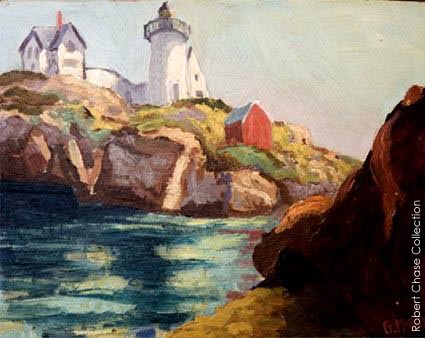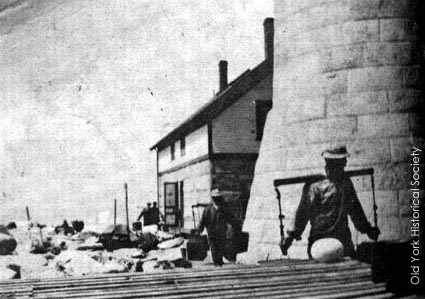|
FRESH STUFF DAILY |
|
|
||
|
|
||
|
|
||
|
SEE ALL SIGNED BOOKS by J. Dennis Robinson click here |
||
Page 2 of 2
ABOUT THE AUTHOR Jane Molloy Porter was born in Boston and received a bachelor’s degree in art history from Radcliffe College in 1952. Her family summered on the Maine coast at Bucks Harbor from the time she was a young girl. Jane’s mother, Anne Molloy, was a writer whose fiction for young people included The Christmas Rocket and The Mystery of the Pilgrim Trading Post. Her 1949 book, Celia’s Lighthouse, told the story of the poet Celia Leighton Thaxter, who lived as a girl on White Island in the Isles of Shoals, where her father was the lighthouse keeper. Porter lived in St. Louis, Missouri, from the mid-1960s to 1984. While there, she did research for the Landmarks Association of St. Louis and co-authored the book Compton Heights: A Historical and Architectural Guide. She moved to Portsmouth, New Hampshire in 1984. The original impetus for Friendly Edifices goes back to 1985, when Porter and her mother traveled to Rockland, Maine, to attend a conference on lighthouses held by the Maine Historic Preservation Commission. The idea of a book on the lighthouses of the Portsmouth area was suggested, and Porter soon submitted a proposal to the Portsmouth Marine Society. The proposal was accepted, and Porter and her mother—who decided to write a book on the lighthouses around Machias, Maine—began doing in-depth research at the National Archives. Her mother died before she could write her book, and new job concerns caused Porter to shelve work on her project for a few years. From 1986 to 2000, Porter was the keeper of the Portsmouth Athenaeum, which was founded in 1817 and is one of only 18 membership libraries in the U.S.
FROM THE PUBLISHER Lighthouses have long fascinated more people than just the mariners for whom the lights were built. The sight of a light shining through the coastal blackness seems to lend comfort and reassurance even to people who are safely ashore. Worldwide, lighthouses stir the imaginations of artists, poets, and writers. The five lighthouses of the Piscataqua region of New Hampshire and Maine are among the most admired structures of their type in America. Nubble Light in York, Maine, is perhaps the most photographed light in the world. And Boon Island Light, just offshore from Nubble, captivated readers of Kenneth Roberts’ tale of shipwreck and cannibalism in the early 1700s. American impressionist Childe Hassam painted White island Light at the Isles of Shoals numerous times, inspired by his friend and fellow artist, the poet Celia Thaxter who spent her childhood at the lighthouse. New Castle’s Fort Constitution Light dates back to the time of John Wentworth, New Hampshire’s last royal governor As the American Revolution began, Wentworth spent his last days in New Hampshire sheltered in the fort beneath the light’s shadow. For author Jane Porter, these tales of tragedy, beauty, and intrigue are only the tip of the story that begins with politicians and building contractors, and continues on the lighthouse keepers and their families. The construction of a lighthouse is not a simple matter. In addition to being able to project a warning light, the structure also must be able to withstand the foul coastal weather, especially here where the North Atlantic brings crashing waves and strong winds. Before a lighthouse could be built, funds had to be authorized usually from public sources, and politicians, whether local or state or national, had to be convinced that the expenditure is warranted. After lighthouse specifications were written, contractors had to carry out those plans. Bricks, wood, iron, and steel have supported the local lights for centuries, although four of the five lighthouses have been replaced at least once. Finally, the lights had to be maintained, a task originally charged to a keeper and often his family lived with him. Local lighthouses had resident families for many years and often the whole family was required to assist the keeper in lighting the lamps and cleaning the protective glass. Celia Thaxer’s strongest memories were of helping her father on White Island. The romance of island living could vanish quickly when a storm threatened to extinguish the light and crashing waves sometimes shook the very structure. Now all the keepers are gone and the lights are electrified, powered directly from the shore or by solar panels on the islands. In the current era, the lights themselves have nearly become redundant because modern vessels of all sizes carry detailed charts, radar, and other navigational equipment that usually makes a visual sighting of a light unnecessary. Today lighthouses are prized more for their historical importance and pictorial beauty then for their value to mariners. In addition to the extensive details about lighthouse construction, maintenance, and operation, the author also discusses the design and placement of various aids to navigation, such as the river and ocean buoys that protect mariners from hidden rocks and ledges, fog signals, and breakwaters that created safe harbors.
Please visit these SeacoastNH.com ad partners.
News about Portsmouth from Fosters.com |
| Thursday, April 18, 2024 |


|
Copyright ® 1996-2020 SeacoastNH.com. All rights reserved. Privacy Statement
Site maintained by ad-cetera graphics






















